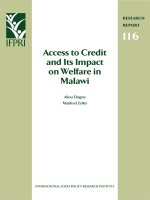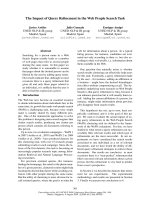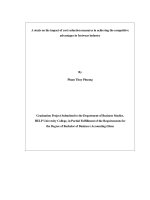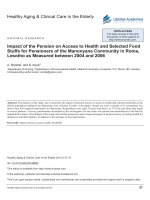Impact of the Pension on Access to Health and Selected Food Stuffs for Pensioners of the Manonyane Community in Roma, Lesotho as Measured between 2004 and 2006 docx
Bạn đang xem bản rút gọn của tài liệu. Xem và tải ngay bản đầy đủ của tài liệu tại đây (399.72 KB, 5 trang )
Healthy Aging & Clinical Care in the Elderly 2012:4 27–31
doi: 10.4137/HACCE.S8565
This article is available from .
© the author(s), publisher and licensee Libertas Academica Ltd.
This is an open access article. Unrestricted non-commercial use is permitted provided the original work is properly cited.
OPEN ACCESS
Full open access to this and
thousands of other papers at
.
ORIGINAL RESEARCH
Healthy Aging & Clinical Care in the Elderly 2012:4 27
Healthy Aging & Clinical Care in the Elderly
Impact of the Pension on Access to Health and Selected Food
Stuffs for Pensioners of the Manonyane Community in Roma,
Lesotho as Measured between 2004 and 2006
A. Ranotsi
1
and S. Aiyuk
2
1
Department of Nursing,
2
Department of Environmental Health, National University of Lesotho, P.O. Roma 180, Lesotho.
Corresponding author email:
Abstract: The purpose of the study was to determine the impact of pension money on access to health and selected foodstuffs on the
elderly population residing at the Manonyane area in Roma, Lesotho. A descriptive design was used. A sample of 215 pensioners was
drawn from 830 registered pensioners in Manonyane. Respondents were aged 70-years and above, as 70 is the age when they begin
to receive pension. A survey questionnaire developed by the investigators for this study was piloted and administered in the eld by
trained eld workers. The ndings of this study showed that pensioners used a large percentage of pension money on seeking health for
themselves and their families, in addition to the purchase of food and alcohol.
Keywords: impact, pension, access, health, foodstuffs
Ranotsi and Aiyuk
28 Healthy Aging & Clinical Care in the Elderly 2012:4
Background of the Study
The Kingdom of Lesotho is an independent demo-
cratic nation situated in the Southern part of Africa.
It is a landlocked enclave completely surrounded by
the Republic of South Africa. It is a small country
covering a land area of approximately 30,000 square
Kilometers. The highlands form three quarters of the
country and they rise up to 3,500 meters in the Drak-
ensburg Maluti Mountain range. According to the
United Nations Development Program
1
the country is
regarded as one of the least developed in the world.
In 2004 the Lesotho government decided to provide
pensions for the elderly of the country from age 70
upwards. The pension was set at Z150.00 a month,
which is slightly above the United Nations (UN) pov-
erty line.
1
The money was paid through the local Post
Ofces. The registration of people eligible for pen-
sion started in September 2004.
In early 2005 the National University of Lesotho
established a multidisciplinary research group to
study the effects of the new pension on the lives of the
recipients. All Faculties were involved in the study. The
Faculty of Health Sciences was tasked with studying
the impact of the pension on access to food and health.
Introduction
The world has recently experienced a rapid increase
in its elderly population. The World Health Organi-
zation
2
categorizes the elderly as all persons above
the age of 60. The demographic transition reecting
the decline in birth rates over the last few decades
contributes to this trend. This is especially observ-
able in developing countries. The United Nations
predicts that the elderly population will increase by
20% by the year 2050. This group will then constitute
more than two billion people. These changes are more
dramatic in developing countries where population
age distribution used to be dominated by the young,
and relatively few people survived into old age.
3
As the proportion of the very old and the very young
increases, the proportion of those in their youth and
middle age diminishes. The dependency ratio, dened
as the number of economically active persons that
are available to support the non-economically active,
the very young and the elderly, declines rapidly. This
decline is compounded by the increased attainment
of higher educational levels by younger generations,
especially women, who, for career reasons and economic
necessity, increasingly engage in paid employment
away from home. No longer are they available to care
for the elderly as they did in the past.
4,5
Other factors reducing the household’s ability to
provide care for the elderly include the migration
of young people and the effects of the HIV/AIDS
pandemic. The HIV/AIDS pandemic is character-
ized by the premature death of young and economi-
cally active people, leaving the elderly as caregivers
instead of them being cared for. Many elderly people
are therefore faced with the dilemma of either living
alone or having to take care of very young, orphaned
grandchildren.
4,5
This demographic transformation has profound
implications on the continued social integration and
the provision of health and social services for the
elderly. The old people in most developing countries
are vulnerable to malnutrition, and to infectious and
other diseases.
1
Lesotho, like many developing countries, is being
affected by an increase in the elderly population.
According to UNDP,
1
the Lesotho’s population above
60 years of age is projected to increase from 4.2%
in 2003 to 5.8% in 2015.
6
Lesotho has accepted and
is signatory to the International Labor Organization’s
(ILO) conventions on social protection and has to
adhere to its responsibility of providing social security
to the vulnerable people, including the elderly. These
commitments involved the introduction of a monthly
non-contributory old age pension in November 2004.
It is provided as a cash transfer to the amount of
ZAR 150.00 per month to citizens aged 70 years and
above.
7
Methodology
The permission and consent to do the study was
obtained from the local chiefs and the participants,
after detailed explanations were made regarding its
purpose. The latter participated willingly without any
coercion and were assured that their names would not
be recorded on the questionnaire documents. They
were informed that they were free to pull out any time
if they so desired. It is worth noting that at the time of
the study, there was no established Ethics Committee
in the country through which the questionnaire and its
administration could be cleared.
Impact of pension on access to health and selected foodstuffs
Healthy Aging & Clinical Care in the Elderly 2012:4 29
The area for this pilot study was the Manonyane
administrative district in Roma, where the National
University of Lesotho (NUL) is situated. The sam-
ple was randomly drawn from 215 out of a total of
830 elderly pensioners. The Pensioners’ names, sex,
age and places of residence were obtained from the
Pensions ofce of the Ministry of Finance in Mas-
eru which is the capital town in the country. Ten sub-
areas across the Manonyane electoral district were
chosen. The sampling procedure involved selection
of rst 10–12 pensioners alphabetically on the list of
each village of Manonyane.
Data were collected by trained eld workers using a
questionnaire that was developed by the investigators.
The questionnaire was piloted in the village of
Nazareth which is relatively close to the university
but distant from the study area. It was administered to
a group of 10 respondents selected to be representa-
tive of the pensioner population that would eventu-
ally be used in the main survey. The unclear questions
were revised, while some were dropped. A few new
questions were added.
The questionnaire was administered through face to
face interviews. Participants were interviewed in their
households. Interviews were conducted in the local
language (Sesotho) but responses were recorded in
E nglish. It included questions about the common foods
pensioners ate and whether they were able to satisfy
their hunger, and their ability to access health care. Data
were cleaned by checking and correcting entry errors
and inconsistencies, then entered on to spreadsheets
and analyzed. Tables were produced and cross tabula-
tions were performed, to identify points of interest.
Findings
Characteristics of the pensioners
surveyed
Basic demographic information was drawn from the
pensioners (Table 1).
Pensioners’ access to health care
The distance to the nearest health care services was
established so as to determine how far Pensioners
need to travel to reach them (Table 2).
The study also established whether the respondents
were able to visit the health services. About 71% of
the pensioners were able to go to the nearest health
facility by themselves, while 26% needed help from
other people. Only 3% were not able to visit a health
facility at all.
The study established the views of the
pensioners about the importance of visiting dif-
ferent health s ervices. They were asked to rank in
order of importance among visits to clinic, village
health worker, traditional healer or buying medicines
(Table 3).
VHW signies village health worker
Pensioners were then requested to indicate which
health services they spent more money on and whether
their health has improved. The information was then
cross tabulated with sex (Table 4).
Cross tabulations showed that men visited the
hospital more often 18% than women 9%. Also
10% of men and 7% of females spent more money
on medicines. Men also helped others to visit health
facilities 17% of men and 10% of women. More
men than women thought it was most important
to consult traditional healers. More males reported
an improved health than females, 21% males and
13% females.
Table 1. Characteristics of the study sample.
Men/Women 34%/66% Living with spouse Yes 30%/No 70%
Average age 77 Spouse a pensioner Yes 20%/No 80%
Head of family Yes 30%/No 70% Literate Yes 66%/No 34%
Living alone Yes 30%/No 70% Christian Yes 98%/No 2%
Wodowed Yes 65%/No 35% Lesotho national Yes 100%/No 0%
Table 2. Distance to the nearest health services.
0–1 km 31%
2–5 km 22%
6–9 km 30%
More than 9 km 15%
Don’t know/No answer 2%
Ranotsi and Aiyuk
30 Healthy Aging & Clinical Care in the Elderly 2012:4
Impact of pension support on pensioners’
food expenditure
As many as 61% of pensioners responded that they
used their pension money to buy more food. An aver-
age of ZAR 93.00 was used to buy food monthly.
Pensioners also stated that apart from having more
food since they received the pension money, they also
were able to buy a variety of food, such as milk, eggs,
sugar, cakes and sweets.
The study also established whether the pensioners
were able to satisfy their hunger with the food they
bought with the pension money (Table 5).
After receiving the pension 10% were still not able
to satisfy their hunger. It was just 1% of pensioners
who had more than enough food after the introduc-
tion of the pension.
As many as 53% of pensioners reported they
used pension money to buy alcohol for themselves
while 42% bought if for themselves and other people.
The mean extra money spent on alcohol was ZAR
21.00. About 5% of the respondents declared to
have increased their alcohol spending by ZAR 50.00
or more since receiving the pension. Apart from
drinking alcohol, 44% of the pensioners i nterviewed
also smoked, and, as a result, they spent some of the
pension money on tobacco for themselves and oth-
ers. The mean extra money spent on tobacco was
ZAR 13.00.
Discussion
Pensioners access to health
The pensioners travel various distances to reach the near-
est health services. Since chronic diseases are a source
of stress to the elderly, without a source of income they
would not be able to pay for transport to reach the health
facilities. With the initiation of monthly pension they
were able to access health services and also had some
money to spare. According to Cohen & Hoberman
8
the
monthly income makes the elderly to perceive illness
as less stressful. It is therefore evident that the pension
money had contributed to the ability of the elderly to pay
for health services and to access health care.
The result of the survey indicated that, as with the
elderly in other countries, the pensioners in Manon-
yane spent their pension income on their own health
and for other family members. This is also common
with pension beneciaries in other developing coun-
tries such as South Africa and Namibia, where other
people benet from the pension allowance.
9
Pensioner’s habits (drinking
and smoking)
Half of smoking pensioners sometimes bought
tobacco and alcohol for other people with their pen-
sion income. This is an indication that pensioners
were able to socialize and enjoy companionship of
others, facilitated by their monthly income. According
to Laniel
10
social events in Lesotho are celebrated by
drinking and smoking together with companions.
Table 3. Pensioners views on importance of visiting various health services.
Health service Most important Important Less important Not important
Visits to clinic 73.5% 20.8% 0.9% 4.7%
Visits to VHW 17.9% 20.8% 2.6% 38.7%
Visits to traditional healer 16.0% 8.5% 10.4% 4.7%
Buying medicines 47.0% 36.7% 9.4% 4.7%
Table 4. Cross tabulations; pensioners spending on health
services and reporting improved health, by sex.
Males Females Difference
Frequent hospital
visits
18% 9% 9%
Spending money
on medicines
10% 7% 3%
Visiting a traditional
healer
6% 3% 3%
Reporting improved
health
21% 13% 8%
Table 5. Percentage of pensioners able to satisfy hunger.
Enough food
to satisfy hunger
Before getting
pension
After getting
pension
Never 20% 10%
Sometimes 47% 47%
Always 36% 46%
Always had more
than enough
0.50% 1%
Impact of pension on access to health and selected foodstuffs
Healthy Aging & Clinical Care in the Elderly 2012:4 31
Pensioner’s access to food
The elderly reported an increased access to food
for them and their households with the introduction
of the pension money. Access to food included the
quantity and variety, such as beans, milk, eggs and
meat.
The positive outcomes of the pension have also
been demonstrated by the ndings that the percentage
of pensioners unable to satisfy their hunger dropped
by 10% since the introduction of the pension. Other
pensioners however reported no difference in their
ability to satisfy hunger. It can be concluded that
these are people who have more needs than the pen-
sion money can satisfy.
8,11
Conclusion
The ndings of this study indicate that pension
money as appraised by the elderly of Manonyane
has been interpreted as valuable in the sense that
it has contributed to the improvement of house-
hold access to food and to the health services of its
beneciaries.
It is therefore apparent that the old age pension
is a useful for the well-being of the Manonyane
elderly.
Recommendations
• More studies need to be done to determine
whether the pension money has contributed to
better quality of life and nutritional status for the
pensioners.
• There is need for further investigation on this
i mportant issue of access to food and health
services for pensioners, in order to obtain a
g eneralization for the country, and including other
variables.
Limitations of the Study
• The study only focused on access to health care
and selected foods, it cannot therefore be gen-
eralized to include broader issues of health and
nutrition.
• The study cannot be generalized beyond the
Manonyane area where it was conducted.
Author Contributions
Conceived and designed the experiments: AR.
Analysed the data: AR and SA. Wrote the rst draft of
the manuscript: AR. Contributed to the writing of the
manuscript: SA. Agree with manuscript results and
conclusions: SA. Jointly developed the structure and
arguments for the paper: AR and SA. Made critical
revisions and approved nal version: AR and SA. All
authors reviewed and approved of the nal manuscript.
Disclosures and Ethics
As a requirement of publication author(s) have pro-
vided to the publisher signed conrmation of compli-
ance with legal and ethical obligations including but
not limited to the following: authorship and contribu-
tor ship, conicts of interest, privacy and condenti-
ality and (where applicable) protection of human and
animal research subjects. The authors have read and
conrmed their agreement with the ICMJE author-
ship and conict of interest criteria. The authors have
also conrmed that this article is unique and not under
consideration or published in any other publication,
and that they have permission from rights holders
to reproduce any copyrighted material. Any disclo-
sures are made in this section. The external blind peer
reviewers report no conicts of interest.
References
1. UNDP (2005). Human development report 2005, New York, USA.
2. Cohen S, Hoberman HM. Positive events and social support as buffers of
life to change stress. Journal of Applied Social Psychology. 1983;13:99–125.
3. Barrientos A, Gorman M, Heslop A. Old age poverty in developing c ountries:
contributions and dependence in later life. World Development. 2003;31(3):
555–70.
4. Basiotis P. Food insufciency and the nutritional status of the elderly
population. Family Economics and Nutrition Review. 2000;1392:58–6.
5. Bureau of statistics. Lesotho population sata sheet, Maseru, Lesotho; 2001.
6. Olson CM. Nutrition and health outcomes associated with food insecurity.
Journal of Nutrition. 1999;129:521S–4.
7. Devereux S. Forum for food security in Southern Africa: policy options for
increasing the contribution of social protection to food security. Institute of
Development Studies, University of Sussex. 2003.
8. Cohen S, Hoberman HM. Positive events and social support as buffers of life
to change stress. Journal of Applied Social Psychology. 1983;13:99–125.
9. Bureau of statistics lesotho population data sheet, Maseru, Lesotho; 2003.
10. Laniel L. Cannabis in lesotho: A preliminary survey. Discussion paper
No. 34 Paper presented at the second annual conference of the MOST/
UNESCO/UNDP project. Rio de Janeiro Oct 1998:1994–2003.
11. Cohen S, McKay G. Social support, stress, and the buffering hypothesis:
A theoretical analysis in Baun A, Taylor SE, Singer JE, editors. 1984.
12. International labor organization (UN) in-depth review of the social security
Programmes. ILO Facts; 1972
13. WHO keep t for life: meeting the nutritional needs of older persons,
Malta; 2002.









